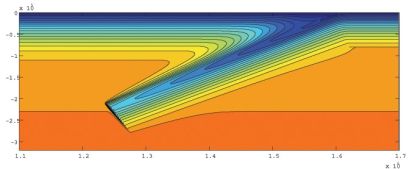This weekend, Ake Fagereng from the UCT Geology department became
the first UCT researcher to use the UCT High Performance Cluster in
ICTS's data centre. The HPC allowed him to run several jobs at
once; with each job taking between 3 and 10 hours to complete. Andrew
Lewis, one of ICTS's two research support engineers, says "While
e-NMR have been using our hardware for some time, this is the first work
submitted by a UCT researcher."
 Figure:
Thermal structure of a theoretical subduction zone, in a 2d cross-section
perpendicular to the trend of the margin, 100degC contour interval.
Mr Fagereng explains: "The model we tried calculates the thermal structure of an evolving subduction zone. It was published as applied to the New Zealand plate boundary by Fagereng & Ellis (Earth and Planetary Science Letters, 2009), and work on applying the model to other margins globally is ongoing as a collaboration between UCT and GNS Science (New Zealand).
I am currently also working on applying the model to predict what the thermal structure of an Archean subduction zone would have been, in collaboration with Gary Stevens' group at Stellenbosch, for use in their work on the Barberton Greenstone Belt. The data we just produced on the ICTS hardware is a first step towards the Barberton model, although more trial and failure is required before we get a model that matches observational data."
ICTS would like to take this opportunity to thank the EBE faculty for their assistance. The jobs that Mr Fagereng ran required the use of Matlab, a software application for which ICTS doesn't own any licences. Erica le Roux, from EBE, kindly allowed ICTS to use their licence server so that a legitimate copy of Matlab could be used in the data centre.
Figure:
Thermal structure of a theoretical subduction zone, in a 2d cross-section
perpendicular to the trend of the margin, 100degC contour interval.
Mr Fagereng explains: "The model we tried calculates the thermal structure of an evolving subduction zone. It was published as applied to the New Zealand plate boundary by Fagereng & Ellis (Earth and Planetary Science Letters, 2009), and work on applying the model to other margins globally is ongoing as a collaboration between UCT and GNS Science (New Zealand).
I am currently also working on applying the model to predict what the thermal structure of an Archean subduction zone would have been, in collaboration with Gary Stevens' group at Stellenbosch, for use in their work on the Barberton Greenstone Belt. The data we just produced on the ICTS hardware is a first step towards the Barberton model, although more trial and failure is required before we get a model that matches observational data."
ICTS would like to take this opportunity to thank the EBE faculty for their assistance. The jobs that Mr Fagereng ran required the use of Matlab, a software application for which ICTS doesn't own any licences. Erica le Roux, from EBE, kindly allowed ICTS to use their licence server so that a legitimate copy of Matlab could be used in the data centre.
 Figure:
Thermal structure of a theoretical subduction zone, in a 2d cross-section
perpendicular to the trend of the margin, 100degC contour interval.
Mr Fagereng explains: "The model we tried calculates the thermal structure of an evolving subduction zone. It was published as applied to the New Zealand plate boundary by Fagereng & Ellis (Earth and Planetary Science Letters, 2009), and work on applying the model to other margins globally is ongoing as a collaboration between UCT and GNS Science (New Zealand).
I am currently also working on applying the model to predict what the thermal structure of an Archean subduction zone would have been, in collaboration with Gary Stevens' group at Stellenbosch, for use in their work on the Barberton Greenstone Belt. The data we just produced on the ICTS hardware is a first step towards the Barberton model, although more trial and failure is required before we get a model that matches observational data."
ICTS would like to take this opportunity to thank the EBE faculty for their assistance. The jobs that Mr Fagereng ran required the use of Matlab, a software application for which ICTS doesn't own any licences. Erica le Roux, from EBE, kindly allowed ICTS to use their licence server so that a legitimate copy of Matlab could be used in the data centre.
Figure:
Thermal structure of a theoretical subduction zone, in a 2d cross-section
perpendicular to the trend of the margin, 100degC contour interval.
Mr Fagereng explains: "The model we tried calculates the thermal structure of an evolving subduction zone. It was published as applied to the New Zealand plate boundary by Fagereng & Ellis (Earth and Planetary Science Letters, 2009), and work on applying the model to other margins globally is ongoing as a collaboration between UCT and GNS Science (New Zealand).
I am currently also working on applying the model to predict what the thermal structure of an Archean subduction zone would have been, in collaboration with Gary Stevens' group at Stellenbosch, for use in their work on the Barberton Greenstone Belt. The data we just produced on the ICTS hardware is a first step towards the Barberton model, although more trial and failure is required before we get a model that matches observational data."
ICTS would like to take this opportunity to thank the EBE faculty for their assistance. The jobs that Mr Fagereng ran required the use of Matlab, a software application for which ICTS doesn't own any licences. Erica le Roux, from EBE, kindly allowed ICTS to use their licence server so that a legitimate copy of Matlab could be used in the data centre.